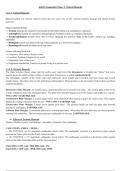College aantekeningen
AQA GCSE Geography Paper 1 Section A: Natural Hazards
- Vak
- Instelling
Detailed summary of spec points for section A of the AQA GCSE geography paper 1, containing important and accurate case study information on Nepal, Chile and UK weather events. Written by a grade 9 student and has everything clearly explained to be written word-for-word in an exam
[Meer zien]




